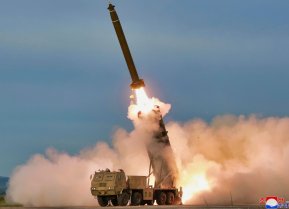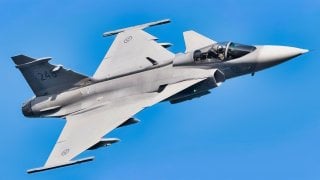JAS 39 Gripen: The Fighter Jet Ukraine Needs to Fight Russia?
Could Ukraine get the JAS 39 Gripen like it is now getting older F-16 fighter jets from other NATO partners? It may end up becoming a reality.
JAS 39 Gripen – the plane that Ukraine needs to fight Russia? In December, Ukraine’s Minister of Defense met with the Supreme Commander of the Armed Forces of Sweden to discuss increased collaboration between the two countries.
Notably, the subject of potentially delivering Sweden’s JAS 39 Gripen aircraft to Ukraine was discussed at length during the meeting.
As quoted in the press, Deputy Minister Ivan Gavilyuk noted that “some associated issues are tied to NATO (the North Atlantic Treaty Organization), however, we’re (Ukrainians) hoping that our combined efforts will lead to the acquisition of these aircraft.”
As Stockholm’s application to join the intergovernmental military alliance remains under review, its defense capabilities and exchanges will continue to be heavily scrutinized.
Could Ukraine get the JAS 39 Gripen like it is now getting older F-16 fighter jets from other NATO partners? Would it help in combatting Russia?
Introducing the JAS 39 Gripen
The JAS-39 was derived from Sweden’s need to upgrade its aging fleet of Saab 25 Drakens and Saab 37 Viggens.
During the 1970’s and 1980’s, Stockholm contemplated procuring a foreign made fighter, including the American-made F-16 Fighting Falcons and F/A-18 Hornets in addition to French Mirages.
Ultimately, however, Swedish officials decided to stick with a domestic Saab product. The government began a study to develop a versatile platform capable of “JAS” or Jakt (air-to-air), Attack (air-to-surface), and Spaning (reconnaissance) functions.

The primary requirement of the Gripen’s design was a short field ability to enable “defensive dispersed basing” in case an invasion was to occur, and Sweden’s jets were spread too far and wide to lead an effective coordinated strike. Since maintaining multiple airfields is difficult, the Gripen needed to be able to land on runways as short as 2,600 feet long.
By 1980, JAS Industry Group was established as a collaborative venture between Saab-Scania, Svenska Radioaktiebolaget, Volvo Flygmotor, LM Ericsson and the industrial arm of the Swedish armed forces Forsvarets Fabriksverk.
The single-seat, fly-by-wire, mach-capable aircraft first debuted in 1987. However, issues involving the platform’s fly-by-wire system delayed the Gripens’ entry to service with the Swedish Air Force until 1997.
The Gripen’s partners and exports
In the mid-1990’s, British Aerospace worked jointly with Saab to market the Gripen as an export fighter platform.
In 1999, this partnership first saw success when the Czech Republic and Hungary purchased the JAS 39 Gripens after joining the NATO alliance. Soon after, South Africa also would become a foreign client of Saab, acquiring 26 Gripens for their own military.

More recently in 2014, Brazil agreed to procure 28 of the latest Gripen variants. The Gripen E features an array of enhanced capabilities, including its avionics and electronic warfare systems.
JAS 39 Gripen: Specs & Capabilities
The Gripen’s cockpit has a Saab Avitronics EP-17 electronic display suite with three multifunction displays and other advancements. In terms of armament, the Swedish fighter is quite formidable.
The JAS 39 Gripen features seven external hardpoints for carrying payloads, which include air-to-air missiles like the MBDA MICA, Raytheon AIM-120B AMRAAM, and Lockheed Martin/Raytheon Sidewinder AIM-9L.
As detailed by Airforce Technology, “Sidewinder, mounted on the wingtips, is an all-aspect attack, short-range missile for enhanced dogfight capability. Air-to-surface missiles include the radar-guided Saab RBS15F anti-ship missile and Raytheon Maverick missile. In July 2008, the Hungarian Air Force’s Gripen fighters successfully test-fired Sidewinder air-to-air missile.”
Will the Gripen Help Ukraine?
For nearly two years, Russia has yet to slow down the pace of its ongoing invasion of Ukraine. NATO allies have provided Kyiv with billions of dollars’ worth of military aid to support its defensive efforts against Moscow. From main battle tanks (MBTs) and fighting vehicles to munitions and unmanned aerial vehicles, Ukraine is stocked with some of the best military systems available across the globe.

In early 2023, U.S. President Joe Biden surprised officials when he signaled that the American fourth-generation F-16 fighter platform could be delivered to Ukraine. This reversal in policy signaled to other NATO allies that training Ukrainian pilots on more advanced airframes was potentially the way to go. Ukrainian officials have had their eyes set on the JAS 39 Gripen since this time.
The Numbers Challenge
The Swedish Air Force only operated around 70 Gripens today, with another 60 on order. Therefore, even if these jets were given the green light to be delivered to Kyiv, only a small number would actually be provided. Additionally, Sweden is not officially a NATO member at the moment and its position next to Russia makes the country particularly vulnerable. It would be challenging for Stockholm to give up the small number of fighters it currently possesses in light of Moscow’s unending hostile behavior in the region. However, the addition of Gripens into Ukraine’s aerial arsenal would undoubtedly elevate its capabilities.

Like the ongoing process for the F-16 Fighting Falcons, Ukrainian pilots will need time to learn how to fly the Swedish jets properly. If Sweden does deliver some Gripen fighters to Kyiv in the upcoming months, the new Gripen E variants will likely not be included.
About the Author: Maya Carlin
Maya Carlin, National Security Writer with The National Interest, is an analyst with the Center for Security Policy and a former Anna Sobol Levy Fellow at IDC Herzliya in Israel. She has by-lines in many publications, including The National Interest, Jerusalem Post, and Times of Israel. You can follow her on Twitter: @MayaCarlin. Email the author: [email protected].
All images are Creative Commons.


